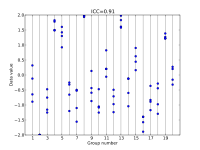
Photo from wikipedia
Modeling longitudinal trajectories and identifying latent classes of trajectories is of great interest in biomedical research, and software to identify latent classes of such is readily available for latent class… Click to show full abstract
Modeling longitudinal trajectories and identifying latent classes of trajectories is of great interest in biomedical research, and software to identify latent classes of such is readily available for latent class trajectory analysis (LCTA), growth mixture modeling (GMM) and covariance pattern mixture models (CPMM). In biomedical applications, the level of within‐person correlation is often non‐negligible, which can impact the model choice and interpretation. LCTA does not incorporate this correlation. GMM does so through random effects, while CPMM specifies a model for within‐class marginal covariance matrix. Previous work has investigated the impact of constraining covariance structures, both within and across classes, in GMMs—an approach often used to solve convergence problems. Using simulation, we focused specifically on how misspecification of the temporal correlation structure and strength, but correct variances, impacts class enumeration and parameter estimation under LCTA and CPMM. We found (1) even in the presence of weak correlation, LCTA often does not reproduce original classes, (2) CPMM performs well in class enumeration when the correct correlation structure is selected, and (3) regardless of misspecification of the correlation structure, both LCTA and CPMM give unbiased estimates of the class trajectory parameters when the within‐individual correlation is weak and the number of classes is correctly specified. However, the bias increases markedly when the correlation is moderate for LCTA and when the incorrect correlation structure is used for CPMM. This work highlights the importance of correlation alone in obtaining appropriate model interpretations and provides insight into model choice.
Journal Title: Statistics in Medicine
Year Published: 2023
Link to full text (if available)
Share on Social Media: Sign Up to like & get
recommendations!